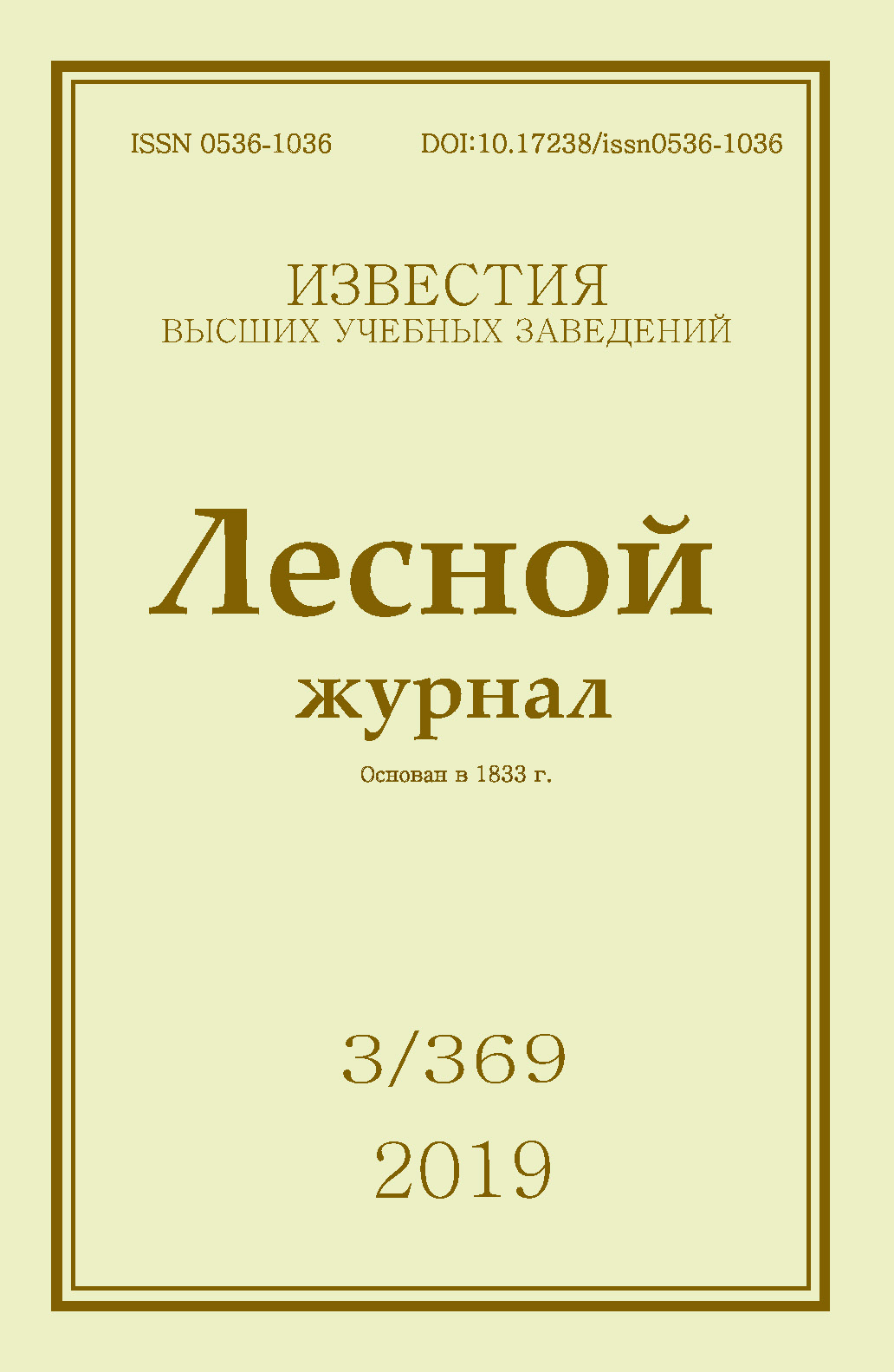Peroxide-Acetate Delignification Patterns of Non-Wood Raw Material Containing Cellulose in the Presence of Sulfuric Catalyst
DOI:
https://doi.org/10.17238/issn0536-1036.2019.3.143Keywords:
flax cellulose fiber, peroxide acetate method, peracetic acid, flax shive, waste recyclingAbstract
The paper considers the properties of cellulose obtained from flax production wastes (shive) by peroxide-acetate method using concentrated sulfuric acid as a catalyst. Pulping of flax shive with 38.5 % of cellulose, 15 % of lignin, and 4.1 % of ash were carried out under the laboratory conditions with 1:10 hydromodulus. The catalyst consumption was 1.0, 0.5 and 0.25 % of the pulping solution volume. Chemical and structural-morphological properties of obtained samples were determined by standard methods. It has been found that the use of peroxide-acetate method of flax shive pulping using sulfuric catalyst allows to obtain a semifinished product with more than 79 % of whiteness and Kappa of 3 units in one step. The most optimal ratio of the catalyst in the pulping solution is 0.5 % by the volume to the pulping solution, which contributes to the quality improvement of flax cellulose: lignin content reducing, whiteness increasing, ash content decreasing, and mean fiber length maintaining. It is shown that reduction in catalyst consumption to 0.25 % (vol.) leads to manufacturing a product with an increased yield (40 %), reduced whiteness and α-cellulose content, which indicates the preservation of the carbohydrate complex during pulping, decrease in the short fiber fractions proportion, and increase in the long fiber proportion due to the reduced fiber damage in the process.
For citation: Arsenyeva D.Yu., Kazakov Ya.V., Okulova E.O., Lagunov A.Yu. Peroxide-Acetate Delignification Patterns of Non-Wood Raw Material Containing Cellulose in the Presence of Sulfuric Catalyst. Lesnoy Zhurnal [Forestry Journal], 2019, no. 3, pp. 143–151. DOI: 10.17238/issn0536-1036.2019.3.143
Downloads
References
Арсеньева Д.Ю., Захарова А.А., Артемов А.В. Особенности пероксидно-ацетатного метода получения целлюлозы из растительного материала // Естественные и технические науки. 2016. № 8(98). С. 30–32.
Арсеньева Д.Ю., Казаков Я.В. Бумагообразующие свойства волокна, полученного из соломы льна пероксидно-ацетатным методом // Проблемы механики цел-люлозно-бумажных материалов: материалы IV Междунар. науч.-техн. конф. (Архангельск, 14–16 сент. 2017 г.) Архангельск: САФУ, 2017. С. 303–307.
Вершинин М.С., Гараева М.Р., Мингазова В.К. Исследование термических характеристик целлюлоз, полученных из растительного сырья // Приволж. науч. вестн. 2017. № 3(67). C. 10–13.
Волкова Н.Н., Обрезкова М.В., Куничан В.А. Получение льняной целлюлозы на технологической линии производства хлопковой целлюлозы // Ползунов. вестн. 2007. № 3. С. 25–27.
ГОСТ 595–79. Целлюлоза хлопковая. Технические условия. Введ. 1980–07–01. М.: Изд-во стандартов, 2002. 14 с.
ГОСТ 11960–79. Полуфабрикаты волокнистые и сырье из однолетних растений для целлюлозно-бумажного производства. Метод определения лигнина. Введ. 1981–01–01. М.: Изд-во стандартов, 1985. 4 с.
ГОСТ 5556–81. Вата медицинская гигроскопическая. Технические условия. Введ. 1982–07–01. М: Изд-во стандартов, 1993. 13 с.
Глазова Н.В., Сатина О.И. НУК: экологически безопасная альтернатива хлору // Птица и птицепродукты. 2010. № 1. С. 58–60.
Коваленко М.В., Сибаева А.Р. Сопоставительный анализ сорбционной способности образцов целлюлозы из древесины лиственницы и образцов целлюлозы из древесины сосны // Theoretical & Applied Science. 2013. № 12(8). С. 31–34. DOI: 10.15863/TAS.2013.12.8.7
Кузнецов Б.Н., Кузнецова С.А., Данилов В.Г., Яценкова О.В. Каталитические методы переработки древесины в целлюлозу с низким содержанием лигнина // Целлюлоза. Бумага. Картон. 2007. № 12. С. 27–30.
Миловидова Л.А., Холмова М.А., Комарова Г.В. Отбелка целлюлозы: метод. указания к выполнению лаб. работ. Архангельск: САФУ, 2011. С. 20–22.
Минакова А.Р. Получение целлюлозы окислительно-органо-сольвентным способом при переработке недревесного растительного сырья: дис. … канд. техн. наук. Архангельск, 2008. 151 с.
Barbash V., Poyda V., Deykun I. Peracetic Acid Pulp from Annual Plants // Cellulose Chemistry and Technology. 2011. Vol. 45, iss. 9–10. Pp. 613–618.
Biswas A., Saha B.C., Lawton J.W., Shogren R.L., Willett J.L. Process for Obtaining Cellulose Acetate from Agricultural By-Products // Carbohydrate Polymers. 2006. Vol. 64, iss. 1. Pp. 134–137. DОI: 10.1016/j.carbpol.2005.11.002
Coletti A., Valerio A., Vismara E. Posidonia oceanica as a Renewable Lignocellulosic Biomass for the Synthesis of Cellulose Acetate and Glycidyl Methacrylate Grafted Cellulose // Materials. 2013. Vol. 6(5). Pp. 2043–2058. DOI: 10.3390/ma6052043
Jackson M., Lewis K.S., Lewis M.S., McKean W.T., Pan W.L. Final Report on Washington State Department of Ecology AG-Burning Permit Project Contract no. C030085 for Lewis Engineering Consultants. 2003. 70 p.
Laamanen L.A., Sundquist J.J., Wartiovaara Y.P. Menetelma valkaistun selluloosamassan valmistamiseksi ligniimpitoisesta raaka-ameesta. Pat. Finland no. 74750. 1988.
Pohjanvesi S., Saan K., Poopius-Levlin K., Sundquist J. Technical and Economical Feasibility Study of the Milox Process // Proceedings of the 8th International Symposium on Wood and Pulping Chemistry June 6–9, 1995, Helsinki, Finland. Helsinki, 1995. Vol. 2. Pp. 231–236.
Poppius K., Laamanen L., Sundquist J., Wartiovaara I., Kaulimakis A. Bleached Рulp by Peroxyacid-Alkaline Delignification // Paperi Ja Puu. 1986. Vol. 68, no. 2. Pp. 87–88, 90–92.
Poppius-Levlin K., Mustonen R., Muovila Т., Sundquist J. Milox Pulping with Acetic Acid-Peroxyacetic Acid // Paperi Ja Puu. 1991. Vol. 73, no. 2. Pp. 154–158.
Sundquist J. From Test Tube to Pilot Plant: The First Miles on the Roach of the Milox Pulping and Bleaching Method. Finn. Chem. Congr., Helsinki, November 12–14, 1991 // Kemiakemi. 1991. No. 108.
Sundquist J. Chemical Pulping Based on Formic Acid: Summary of Milox Research // Paperi Ja Puu. 1996. Vol. 78, no. 3. Pp. 92–95.
Sundquist J., Laamanen L., Poppius K. Problems of Nonconventional Pulping Process in the Light of Peroxyformic Acid Cooking Experiments // Paperi Ja Puu. 1988. Vol. 70, no. 2. Pp. 143, 145–148.







